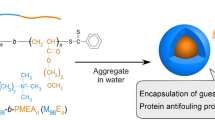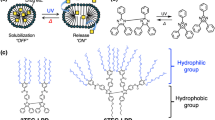Abstract
Lipid vesicles (liposomes) can be formed from [1,2–(methacryloyloxy)dodecanoyl]–L–α–phosphatidylcholine, a photopolymerizable analog of phosphatidylcholine. As compared to conventional liposomes, the photopolymerized vesicles display enhanced mechanical stability and enhanced retention of lipophilic compounds. Thus, while detergents solubilize conventional vesicles and release incorporated lipophilic markers such as cholesterol oleate, the photopolymerized vesicles retain lipophilic compounds even at extremely high detergent concentrations. Photopolymerized vesicles may prove to be useful in certain aspects of the formulation and controlled delivery of hydrophilic and lipophilic drugs.
This is a preview of subscription content, access via your institution
Access options
Subscribe to this journal
Receive 12 print issues and online access
$209.00 per year
only $17.42 per issue
Buy this article
- Purchase on Springer Link
- Instant access to full article PDF
Prices may be subject to local taxes which are calculated during checkout
Similar content being viewed by others
References
Papahadjopoulos, D. (ed.) 1978. Liposomes in Biology and Medicine. Ann. N. Y. Acad. Sci., Vol. 308.
Juliano, R.L. and Layton, D. 1980. Liposomes as a drug delivery system, p. 189–236. In: Drug Delivery Systems: Characteristics and Biomedical Applications. R. Juliano (ed.), Oxford University Press, New York.
Wilson, T. and Cave, L. 1983. New commercial opportunities for liposomes emerge. BIO/TECHNOLOGY 1: 148–154.
Fendler, J.H. 1982. Membrane Mimetic Systems. J. Wiley Interscience, New York.
Regen, S.L., Singh, A., Oehme, G. and Singh, M. 1982. Polymerized phosphatidylcholine vesicles. Synthesis and characterization. J. Am. Chem. Soc. 104: 791–795.
Hub, H.H., Hopfer, B., Koch, H. and Ringsdorf, H. 1980. Polymerizable phospholipid analogs—new stable biomembrane and cell models. Angew. Chem. 19: 938–940.
Johnston, D.X., Sanghera, S., Pons, M. and Chapman, D. 1980. Phospholipid polymers—synthesis and spectral characterization. Biochim. Biophys. Acta 602: 57–69.
O'Brien, D.F., Whitesides, T.H. and Klingbiel, R.T. 1981. The photopolymerization of lipid diacetylenes in biomolecular—layer membranes. J. Polymer Sci., Polymer Lett. 19: 95–101.
Tundo, P., Kippenberger, D.J., Klahn, P.L., Prieto, N.E., Jao, T. and Fendler, J.H. 1982. Functionally polymerized surfactant vesicles: synthesis and characterization. J. Am. Chem. Soc. 104: 456–461.
Fildes, F.J.T. 1981. Liposomes: The industrial viewpoint, p. 465–485. In: Liposomes: From Physical Structure to Therapeutic Applications, C. G. Knight (ed.), Elsevier-North Holland, Amsterdam.
Author information
Rights and permissions
About this article
Cite this article
Juliano, R., Regen, S., Singh, M. et al. Stability Properties of Photopolymerized Liposomes. Nat Biotechnol 1, 882–885 (1983). https://doi.org/10.1038/nbt1283-882
Issue Date:
DOI: https://doi.org/10.1038/nbt1283-882



